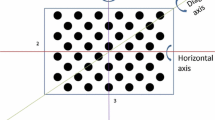Abstract
In the last few years the need for methodologies capable of performing an automated geometric inspection has increased. These methodologies often use 3D high-resolution optical digitisers to acquire points from the surface of the object to be inspected. It is expected that, in the near future, geometric inspection will be requiring more and more the use of these instruments. At present geometric inspection is not profiting from all the opportunities attainable by 3D high-resolution optical scanners or from the numerous tools which can be used for processing the point cloud acquired from the inspected product. For some years now, these authors have been working on a new methodology for automatic tolerance inspection working from a 3D model acquired by optical digitisers. In this paper all the information recognisable in a scanned object is organised into a new data structure, called Recognised Geometric Model (RGM). The final aim is to define a representation of the inspected object for the automatic evaluation of the non-idealities pertaining to the form, orientation and location of the non-ideal features of the acquired object. The key concept of the proposed approach is the capability to recognise some intrinsic nominal properties of the acquired model. These properties are assumed as references to evaluate the non-idealities of the inspected object. With this approach the references of geometric inspection are searched for in the inspected object independently of a tolerance specification and of the availability of a 3D nominal representation. The high-level geometric information within RGM depends on the rules used for its identification. The capability to recognise specific categories of nominal references offers the possibility of introducing new tolerances to be specified. The proposed approach has been implemented in original software by means of which a specific test case has been analysed.









Similar content being viewed by others
References
Prieto, F., Redarce, T., Lepage, R., Boulanger, P.: An automated inspection system. Int. J. Adv. Manuf. Technol. 19(12), 917–925 (2002)
Li, Y., Gu, P.: Inspection of free-form shaped parts. Robotics Computer Integr. Manuf. 21(4–5), 421–430 (2005)
Gao, J., Gindy, N., Chen, X.: An automated GD&T inspection system based on non-contact 3D digitization. Int. J. Prod. Res. 44(1), 117–134 (2006)
Li, Y., Gu, P.: Free-form surface inspection techniques—state of the art review. Computer-Aided Des. 36(13), 1395–1417 (2004)
ISO 1101:2004 Geometrical Product Specifications (GPS)—Tolerances of form, orientation, location and run out (2004)
ASME 14.5Y: Dimensioning and Tolerancing (2009)
Nielsen, H.S.: New concepts in specifications, operators and uncertainties and their impact on measurement and instrumentation. Meas. Sci. Technol. 17(3), 541–544 (2006)
Do Carmo, M.: Differential geometry of curves and surfaces. Prentice-Hall, Englewood Cliffs (1974)
Di Angelo, L., Di Stefano, P., Morabito, A.: Fuzzy sets for geometric shape recognition in triangular meshes. In: Proceedings of the 6th International Conference on Intelligent Processing and Manufacturing of Materials (IPMM), Salerno, Italy, 25–29 June (2007)
ISO 14660–1: Geometrical Product Specifications (GPS)—Geometrical features—Part 1: General terms and definitions (1999)
Cao, Y., Mumford, D.: Geometric structure estimation of axially symmetric pots from small fragments. In: Proceedings of SHAPE Lab. @SPPRA’02 signal processing, pattern recognition and applications iasted international conference, 25–28 June. Crete, Greece (2002)
Di Angelo, L., Di Stefano, L., Morabito, A.E.: Automatic evaluation of form errors in high-density acquired surfaces. Int. J. Prod. Res. 49(7), 2061–2082 (2011). First published on: 26 April 2010 (iFirst)
ISO 12780–1: Geometrical product specifications (GPS)—Straightness—Part 1: vocabulary and parameters of straightness (2011)
ISO 11562: Geometrical Product Specifications (GPS)—Surface texture: profile method—metrological characteristics of phase correct filters (1996)
Author information
Authors and Affiliations
Corresponding author
Rights and permissions
About this article
Cite this article
Di Angelo, L., Di Stefano, P. & Morabito, A.E. Recognition of intrinsic quality properties for automatic geometric inspection. Int J Interact Des Manuf 7, 203–215 (2013). https://doi.org/10.1007/s12008-012-0173-9
Received:
Accepted:
Published:
Issue Date:
DOI: https://doi.org/10.1007/s12008-012-0173-9



